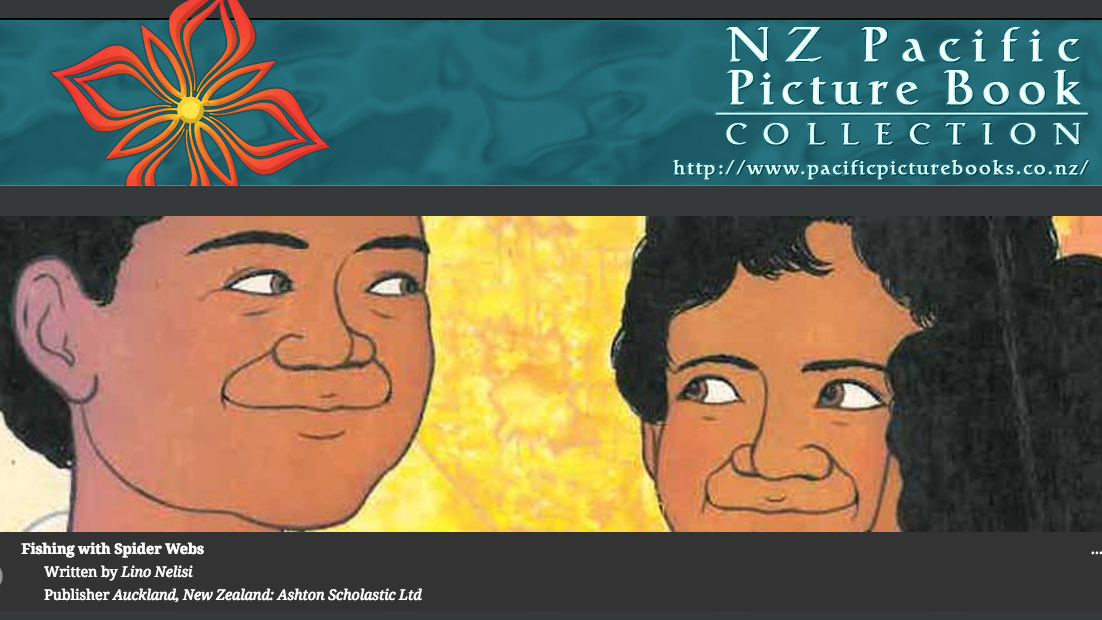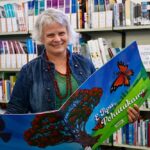Waikato academic Nicola Daly introduces the New Zealand Pacific Picture Book Collection, and calls for more contributions to it.

In 2012 I worked with nine librarians to create a list of picture books which told stories from and about Pacific communities. The list of 36 picture books which resulted, called the New Zealand Pacific Picture Book Collection, includes stories from at least eight Pasifika communities present in New Zealand.
I am Pākehā myself, which I realise does not make me the ideal person for the job of creating this list. To overcome this shortcoming, I ensured that the people who I consulted regarding suitable books were either people with Pasifika heritage and/or librarians with specific responsibility for Pasifika communities. If a title was recommended by these consultants, it was included. I didn’t think it was my place to exclude any title suggested.
You can see the list of books the participants chose at pacificpicturebooks.co.nz. In the last 12 months there have been 7,506 users and 14,662 pageviews of the website.
However, having been created in 2012, the New Zealand Pacific Picture Book Collection already needs updating. It would be great to have replies to this article suggesting books featuring Pasifika writers, illustrators, characters and communities that have been published since the collection was created in 2012 (and ones we didn’t include from prior to 2012). You can leave a comment on The Sapling Facebook page or contact me directly.

My motivation to create the list came from my belief in the power of picture books, and in the particular power of a collection of picture books when created with a specific purpose. I was inspired by the work of Penni Cotton at Roehampton University who created the European Picture book Collection, comprising a book from each of 20 European Union countries. Penni created this collection as a pedagogical tool to be used to create understanding between children in European Union countries. When I saw a display of this collection I thought that we could do with one of these in New Zealand for the Pacific.
Ruth Toumu’a of the University of the South Pacific argues that the development of culturally and linguistically relevant children’s books can go some way towards addressing the less than optimal literacy statistics for Pasifika children in New Zealand and around the Pacific. She refers to the well known windows and mirrors metaphor regarding what is sometimes called ‘multicultural children’s literature’, or books which feature characters from minority communities. This metaphor presents children’s books as having the potential to be windows into other people’s worlds and mirrors reflecting our own worlds. She notes that for Pacific children there are plenty of windows but not enough mirrors. Yet research shows that when children see themselves in the books reading engagement increases and this can also have a positive impact on language acquisition for English as an Additional Language (EAL) students.

It’s interesting to ponder why there are more windows than mirrors in terms of picture books reflecting the stories, heritage, and present realities of Pasifika communities in New Zealand. I am not sure what representation levels are like in the publishing industry currently, but maybe this trend could be turned around by more Pasifika people being in decision-making positions in the publishing industry, and by the institution of targeted funds and awards to encourage the writing and publication of such books.
…maybe this trend could be turned around by more Pasifika people being in decision-making positions in the publishing industry, and by the institution of targeted funds and awards to encourage the writing and publication of such books.
These approaches would also work to support the publication of authentic stories from the community. Authenticity (or lack of it) is a big issue in academic discussions of multicultural children’s literature, and in my opinion, while this can be achieved to some extent via research and consultation, one of the best ways to achieve authenticity is for stories to be written and illustrated by members of Pasifika communities.
Picture books are often underestimated, probably because they are mostly seen as being relevant to very young children. And yet their audience can be much broader than this. In my institution we use them with tertiary adult learners, with pre-service teachers frequently and right across the curriculum. Indeed one of the defining features of children’s literature is that it needs to address two audiences: children for whom it is ostensibly produced, and adults who are in so many gatekeeping positions with respect to children’s literature: deciding what will be published, what will be sold, and often what will be read at home and at school.
Books which are enjoyable to adults are more likely to be purchased, borrowed and read by adults to children. One of my personal favourites from the Pacific Picture Book Collection is Fiapule by Catherine Hannken and Trish Bowles which tells the story of a young Samoan boy who is invited to his friend’s birthday on the same Sunday as his sister’s christening. The story tells about the clash of cultural values and expectations that this invitation exposes, and follows the way that the two families negotiate the dilemma.
I also enjoy Kate Moetaua’s duo, Papa’s Jandals and Papa’s Donuts, both of which tell humorous stories which reflect Cook Island Māori family life.
Sarona Aiono-Iosefa is another author with two books in the collection: The Pipi Swing is about a young girl learning the ‘pipi swing’ from her grandfather. The pipi swing is the dance your body does when you are digging pipis with your toes, and she remembers her late father as she does this dance. Aiono-Iosefa also has Two Cans of Corned Beef and a Manulele in a Mango Tree in the collection, which while based on a traditional English song (the Twelve Days of Christmas) includes many different foods and activities relevant to Pasifika communities.
And because I enjoy these books so much I have read them to my daughter and the pre-service teachers I work with many, many times.

The power of any picture book lies in its its format and its use of multimedia. The brevity of the traditional 32-page format means it can be shared in a relatively short amount of time, and the combination of text and illustration (neither one complete without the other) maximises the media (visual, textual, aural) through which a story is delivered and received. Illustrations have particular significance and power in traditionally oral cultures.
Unfortunately, but perhaps not surprisingly, like many fora in our society, children’s literature is dominated by white middle class characters and their stories. The Cooperative Book Center at the University of Wisconsin, USA which holds most trade books published for children in the Unites States, has published an annual survey since 2002 showing the low proportion of books written or illustrated by or featuring characters who are people of colour.
Unfortunately, but perhaps not surprisingly, like many fora in our society, children’s literature is dominated by white middle class characters and their stories.
In our own country, researchers Alexis Siteine and Tanya Samu have analysed representation of Pacific people in the New Zealand School Journal published between 2002 and 2009 and found that Pacific people were underrepresented in relation to their proportion in New Zealand society. In addition the range of roles in which Pacific characters were presented were limited and did not, for example, show them in positions of power, authority or social recognition. No such analysis appears to have been done for trade books featuring Pacific people in New Zealand, but my experience in working with the librarians who helped put this collection together tells me that at that time there were not large numbers of books featuring Pacific people, communities and languages.
And this brings me back to my belief in the power of a collection. One of the affordances of creating a collection is the increased access it provides to books of a specific nature. In this case it is my hope that the New Zealand Pacific Picture Book Collection is a starting place for teachers, librarians and parents who want to find books which present mirrors for the Pasifika children in their lives, whether at home or at school.
Really for me, that’s it. I truly believe in the power of a story featuring someone you can relate to in helping you explore your own identity and self awareness, and to be fully engaged in a story. I also think such books are important for children from the dominant culture too – to read about different ways of being in the world, to know theirs is not the only way.

Nicola Daly
Nicola Daly is a senior lecturer at Te Kura Toi Tangata, in the Division of Education at the University of Waikato where she teaches courses in children's literature and language learning. Her courses 'An Introduction to Children's Literature' and 'New Zealand Children's Literature Paper' are both offered online. Nicola's research examines the use of languages in picturebooks; she has had fellowships at the Marantz Picture book Collection at Kent State University, the International Youth Library in Munich, Germany, and most recently was a Fulbright New Zealand Scholar based at the Worlds of Words Center, University of Arizona, USA. She runs a picturebook club for University of Waikato staff and students and is the Co-Director of the Waikato Picture Book Research Unit which runs an annual seminar at the Hamilton Campus (November 12 2020 Silent Picturebooks). Registration is at waikato.ac.nz/go/waipru-seminar.



